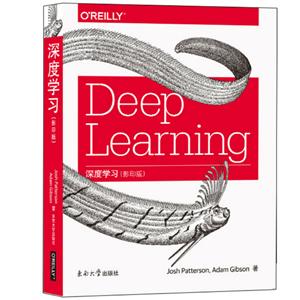有劃線標(biāo)記、光盤(pán)等附件不全詳細(xì)品相說(shuō)明>>
-
>
妙相梵容
-
>
基立爾蒙文:蒙文
-
>
我的石頭記
-
>
心靈元?dú)馍?/p>
-
>
女性生存戰(zhàn)爭(zhēng)
-
>
縣中的孩子 中國(guó)縣域教育生態(tài)
-
>
(精)人類的明天(八品)
深度學(xué)習(xí)(影印版) 版權(quán)信息
- ISBN:9787564175160
- 條形碼:9787564175160 ; 978-7-5641-7516-0
- 裝幀:一般膠版紙
- 冊(cè)數(shù):暫無(wú)
- 重量:暫無(wú)
- 所屬分類:>
深度學(xué)習(xí)(影印版) 本書(shū)特色
(這本書(shū)包含了)開(kāi)發(fā)者所需知道的關(guān)于真實(shí)世界中深度學(xué)習(xí)如何起步的一切。 —— Grant Ingersoll (Lucidworks的CTO)
深度學(xué)習(xí)(影印版) 內(nèi)容簡(jiǎn)介
在引入開(kāi)源Deeplearning4j(DL4J)庫(kù)用于開(kāi)發(fā)產(chǎn)品級(jí)工作流之前,作者Josh Patterson和Adam Gibson介紹了深度學(xué)習(xí)——調(diào)優(yōu)、并行化、向量化及建立管道——任何庫(kù)所需的基礎(chǔ)知識(shí)。通過(guò)真實(shí)的案例,你將學(xué)會(huì)在Spark和Hadoop上用DL4J訓(xùn)練深度網(wǎng)絡(luò)架構(gòu)并運(yùn)行深度學(xué)習(xí)工作流的方法和策略。* 深入機(jī)器學(xué)習(xí)一般概念,特別是深度學(xué)習(xí)相關(guān)概念* 理解深度網(wǎng)絡(luò)如何從神經(jīng)網(wǎng)絡(luò)基礎(chǔ)演化* 探索主流深度網(wǎng)絡(luò)架構(gòu),包括Convolutional和Recurrent * 學(xué)習(xí)如何將特定的深度網(wǎng)絡(luò)映射到具體的問(wèn)題* 一般神經(jīng)網(wǎng)絡(luò)和特定深度網(wǎng)絡(luò)架構(gòu)調(diào)優(yōu)基礎(chǔ)概覽* 為不同的數(shù)據(jù)類型使用DL4J的工作流工具DateVec實(shí)現(xiàn)向量化* 學(xué)習(xí)如何在Spark和Hadoop本地使用DL4J
深度學(xué)習(xí)(影印版) 目錄
1. A Review of Machine Learning
The Learning Machines
How Can Machines Learn?
Biological Inspiration
What Is Deep Learning?
Going Down the Rabbit Hole
Framing the Questions
The Math Behind Machine Learning: Linear Algebra
Scalars
Vectors
Matrices
Tensors
Hyperplanes
Relevant Mathematical Operations
Converting Data Into Vectors
Solving Systems of Equations
The Math Behind Machine Learning: Statistics
Probability
Conditional Probabilities
Posterior Probability
Distributions
Samples Versus Population
Resampling Methods
Selection Bias
Likelihood
How Does Machine Learning Work?
Regression
Classification
Clustering
Underfitting and Overfitting
Optimization
Convex Optimization
Gradient Descent
Stochastic Gradient Descent
Quasi-Newton Optimization Methods
Generative Versus Discriminative Models
Logistic Regression
The Logistic Function
Understanding Logistic Regression Output
Evaluating Models
The Confusion Matrix
Building an Understanding of Machine Learning
2. Foundations of Neural Networks and Deep Learning.
Neural Networks
The Biological Neuron
The Perceptron
Multilayer Feed-Forward Networks
Training Neural Networks
Backpropagation Learning
Activation Functions
Linear
Sigmoid
Tanh
Hard Tanh
Softmax
Rectified Linear
Loss Functions
Loss Function Notation
Loss Functions for Regression
Loss Functions for Classification
Loss Functions for Reconstruction
Hyperparameters
Learning Rate
Regularization
Momentum
Sparsity
3. Fundamentals of Deep Networks
4. Major Architectures of Deep Networks
5. Building Deep Networks
6. Tuning Deep Networks
7. Tuning Specific Deep Networks Architecture
8. Vectorization
9. Using Deep Learning and DL4J on Spark
A. What Is Artificial Intelligence?
B. RL4J and Reinforcement Learning
C. Numbers Everyone Should Know
D. Neural Networks and Backpropagation: A Mathematical Approach
E. Using the ND4J API
深度學(xué)習(xí)(影印版) 作者簡(jiǎn)介
Josh Patterson目前是Skymind的現(xiàn)場(chǎng)工程副總裁。他此前曾在Cloudera擔(dān)任高級(jí)解決方案架構(gòu)師,在Tennessee Valley Authority擔(dān)任機(jī)器學(xué)習(xí)和分布式系統(tǒng)工程師。 Adam Gibson是Skymind的CTO。Adam曾與財(cái)富500強(qiáng)企業(yè)、對(duì)沖基金、公關(guān)公司和創(chuàng)投加速器等機(jī)構(gòu)合作,創(chuàng)建它們的機(jī)器學(xué)習(xí)項(xiàng)目。他在幫助這些公司處理和闡釋大規(guī)模實(shí)時(shí)數(shù)據(jù)方面頗具深厚經(jīng)驗(yàn)。
- >
中國(guó)人在烏蘇里邊疆區(qū):歷史與人類學(xué)概述
- >
二體千字文
- >
小考拉的故事-套裝共3冊(cè)
- >
伊索寓言-世界文學(xué)名著典藏-全譯本
- >
姑媽的寶刀
- >
我從未如此眷戀人間
- >
【精裝繪本】畫(huà)給孩子的中國(guó)神話
- >
巴金-再思錄















